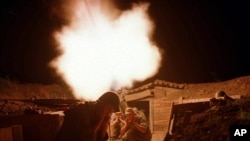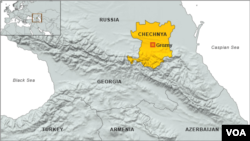Chechnya, one of several small majority Muslim republics in Russia's North Caucasus, has been the scene of two bloody conflicts between separatist rebels and the Russian government during the past two decades.
In 1994, then Russian President Boris Yeltsin sent 100,000 Russian troops into Chechnya to depose the region's separatist leader, Dzhokhar Dudayev. That military intervention sparked a two year conflict that claimed the lives of several thousand Russian troops and tens of thousands of Chechen civilians. Dudayev was killed in a Russian airstrike in April, 1996.
In 1999, Yeltsin's successor, President Vladimir Putin, intervened militarily in Chechnya again, after Chechnya-based Islamic militants mounted an armed incursion into the neighboring region of Dagestan. The ensuing conflict claimed the lives of at least 5,000 Russian troops and 25,000 to 50,000 civilians.
While the Chechen insurgency was initially primarily nationalistic, it took on an increasingly Islamist character over the years. The leader of the insurgency's radical wing, Shamil Basayev, worked together with international jihadist militants like Ibn al-Khattab, a Saudi national with close connections to Osama bin Laden's al-Qaida, who fought Soviet troops in Afghanistan in the 1980s and went to fight in Chechnya in the mid-1990s.
In 2002, Chechen militants seized a theater in the Russian capital Moscow, and 129 hostages were killed when security forces attempted to free them. In 2004, militants loyal to Basayev seized a school in the town of Beslan in North Ossetia, another republic in Russia's North Caucasus. More than 330 people, half of them children, died in that siege.
Also in 2004, several bombings on the Moscow metro that killed dozens of people were blamed on suicide bombers from the North Caucasus.
On August 24, 2004, two Russian airliners blew up in midair almost simultaneously. Authorities later said the planes were brought down by bombs triggered by two female Chechen suicide bombers, and, in September, Basayev took responsibility for bringing the planes down.
Basayev was killed in July, 2006.
While Islamist insurgents have been less active in Chechnya lately, mainly due to the iron-fisted rule of Chechnya's current pro-Moscow leader, Ramzan Kadyrov, they continue to carry out attacks targeting police and other officials in neighboring republics of the North Caucasus, including Dagestan, Ingushetia and Kabardino-Balkaria.
They have also continued to strike Russian targets outside the North Caucasus: In January 2011, an Islamic militant from Ingushetia carried out a suicide bombing at Moscow's Domodedovo that killed 37 people.
In 1994, then Russian President Boris Yeltsin sent 100,000 Russian troops into Chechnya to depose the region's separatist leader, Dzhokhar Dudayev. That military intervention sparked a two year conflict that claimed the lives of several thousand Russian troops and tens of thousands of Chechen civilians. Dudayev was killed in a Russian airstrike in April, 1996.
In 1999, Yeltsin's successor, President Vladimir Putin, intervened militarily in Chechnya again, after Chechnya-based Islamic militants mounted an armed incursion into the neighboring region of Dagestan. The ensuing conflict claimed the lives of at least 5,000 Russian troops and 25,000 to 50,000 civilians.
While the Chechen insurgency was initially primarily nationalistic, it took on an increasingly Islamist character over the years. The leader of the insurgency's radical wing, Shamil Basayev, worked together with international jihadist militants like Ibn al-Khattab, a Saudi national with close connections to Osama bin Laden's al-Qaida, who fought Soviet troops in Afghanistan in the 1980s and went to fight in Chechnya in the mid-1990s.
In 2002, Chechen militants seized a theater in the Russian capital Moscow, and 129 hostages were killed when security forces attempted to free them. In 2004, militants loyal to Basayev seized a school in the town of Beslan in North Ossetia, another republic in Russia's North Caucasus. More than 330 people, half of them children, died in that siege.
Also in 2004, several bombings on the Moscow metro that killed dozens of people were blamed on suicide bombers from the North Caucasus.
On August 24, 2004, two Russian airliners blew up in midair almost simultaneously. Authorities later said the planes were brought down by bombs triggered by two female Chechen suicide bombers, and, in September, Basayev took responsibility for bringing the planes down.
Basayev was killed in July, 2006.
While Islamist insurgents have been less active in Chechnya lately, mainly due to the iron-fisted rule of Chechnya's current pro-Moscow leader, Ramzan Kadyrov, they continue to carry out attacks targeting police and other officials in neighboring republics of the North Caucasus, including Dagestan, Ingushetia and Kabardino-Balkaria.
They have also continued to strike Russian targets outside the North Caucasus: In January 2011, an Islamic militant from Ingushetia carried out a suicide bombing at Moscow's Domodedovo that killed 37 people.








